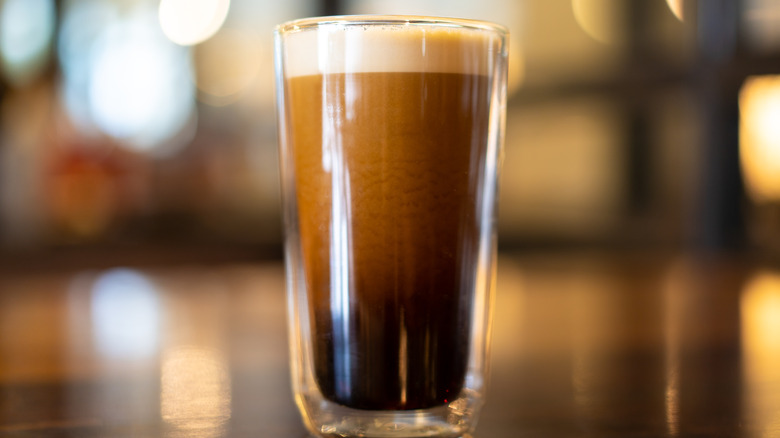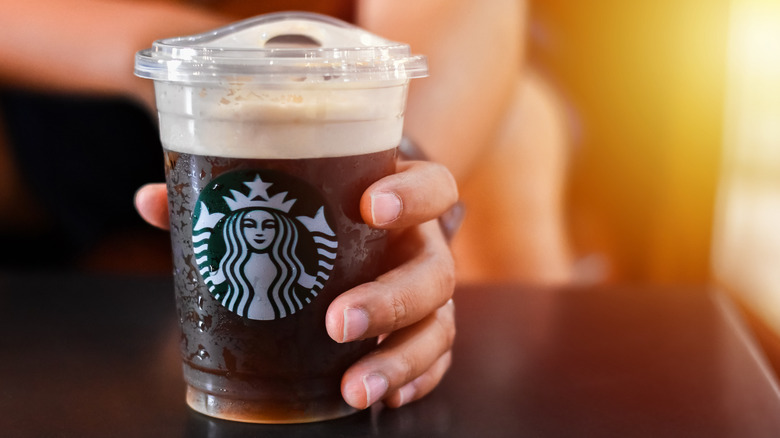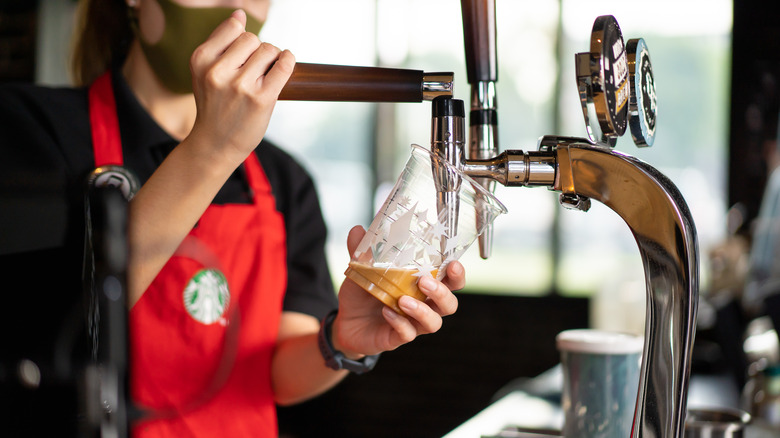How Starbucks' Nitrogen-Infused Coffee Works
"Nitro cold brew" sounds like a coffee-based science experiment, rather than an item you'd find on your local Starbucks menu. Nonetheless, starting in 2016, these futuristic-sounding drinks began appearing at Starbucks stores across the United States, and have amassed a cult following ever since. To those who aren't that into niche coffee trends or haven't tried the drinks, the appeal of nitrogen coffee may sound not so appealing at all — but this gas actually can do miraculous things for an average cup of joe.
Firstly, you should know that nitrogen-infused coffee is directly infused with nitrogen gas, which is not super fizzy, unlike Starbucks' failed coffee-soda hybrid made with sparkling water. The odorless, tasteless gas is injected into the coffee to create an aerated cold brew, with much smaller bubbles than those found in soda or seltzer. Rather than producing a "popping" sensation, the nitrogen creates a creates a creamy, soft, extra-smooth mouthfeel.
Another unique aspect is the way the coffee is stored and served at Starbucks. Nitro cold brew is stored in chilled kegs and pulled from a tap, much like beer, before it's dolled out to customers in cafés. Though the base of nitro drinks are the same as any other cold brew offering, the unique texture created by the nitrogen is truly singular.
Nitrogen's effect on coffee
Infusing drinks with nitrogen may sound like a wild idea, but the gas has been used in the famous stout beer Guinness, as well as other beers, for decades. Using nitrogen instead of carbon dioxide creates finer bubbles and a wonderful froth, with a much smoother mouthfeel. The concept inspired homebrew master and food scientist Nate Armbrust to try the same approach with coffee while working at Stumptown Coffee Roasters. The West Coast-borne innovation picked up buzz among enthusiasts, and Starbucks soon joined in on the novel concept.
Like a good stout, nitrogen-infused cold brew boasts a beer-like head of foam and a deep, rich flavor. The benefit of the gas, apart from adding a gentle aeration and a richer texture, is that it slows down oxidation. Many foods and drinks, like wine, olive oil, and coffee, degrade in taste and quality as they age and get exposed to oxygen for longer periods of time. Infusing cold brew coffee with nitrogen pushes out oxygen, and the unique keg storage method further seals in the drink's freshness, helping to extend the life of its flavor profile.
Tips for ordering nitro cold brew
If you're new to ordering a nitro cold brew drink, sip slowly. Starbucks' tall nitro cold brew contains about 60 milligrams more caffeine than a tall regular cold brew from the company, and about 140 milligrams more than a tall caffè latte. Though you can dilute your cold brew with milk, it's typically served chilled without ice or additives. You'll want to avoid gulping the drink down, so you can appreciate its flavors and avoid an overwhelming caffeine rush.
Starbucks makes its infused coffee by steeping grounds in water for 20 hours before adding nitrogen. The chain claims that the added bubbles make the drink taste sweeter, even without sugar. However, for those with a sweet tooth or a spice tooth, you can customize your order and taking advantage of the many toppings available at your local store. The company even offers Cinnamon Caramel Cream and Vanilla Sweet Cream versions of the drink on its basic menu.
For your own custom creation, you can add warming spices with a few pumps of chai syrup, or build in a surprise by asking for whipped cream or cold foam at the bottom of the cup. But we recommend tasting nitrogen coffee on its own first, so you can see what all the fuss is about.



